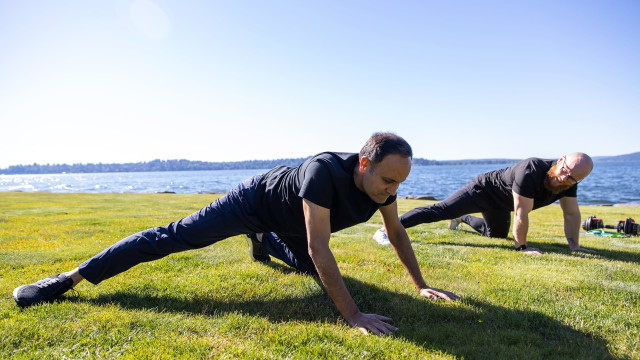Mindful Eating: Unpack Your Hunger

Do you remember the last time you felt low or sad? What was your first reaction to try and cheer yourself up? This question may beget a plethora of answers; however, it is not too far-fetched to deduce that the “feel good” responses would probably involve food. We have all been there at some point seeking comfort through our favorite meals.
Though for many, food can come with negative emotional attachments, which over time, could manifest into disruptive eating patterns. Discerning the type of “hunger” we are experiencing is crucial in removing any negative association or overwhelming emotion that affect our choices with food. Mindfulness can help you deconstruct the eating experience, says Roundglass mindfulness and meditation teacher, Lisa Kring.
Here are a few pointers to navigating emotional eating through mindfulness :
Deconstruct Your Feelings
There are three main streams that guide our moment-to-moment experience, according to Kring. These are the physical — our body and its sensations, the emotional stream, and the mental space. Often when we are not mindful, these become enmeshed as one. “Being mindful can help us deconstruct these feelings,” says Kring.
A 2020 study published in the Journal of Alternative and Complementary Medicine titled “Effects of Mindfulness-Based Intervention on the Treatment of Problematic Eating Behaviors: A Systematic Review” provides evidence supporting the efficacy of the mindfulness-based interventions in helping with a range of problematic eating behaviors. Bringing mindful awareness to internal experiences and automatic patterns can help increase self-acceptance and emotional regulation, which in turn, helps regulate eating patterns. To help break excessive eating or binging patterns, it may be necessary to address underlying emotions, like stress or sadness. When we confuse these feelings with the physical stream, we may end up thinking we are hungry, believes Kring, and these emotional needs must be addressed separately.
Kring says, “Slow down and ask yourself — is this a physical hunger? Are you really you hungry? You may realize, you are not hungry at all, ‘Oh my God, I am starving for company.’ Or, ‘I am really hungry for approval.’ ‘I am craving validation or comfort or reassurance or love.’”
Differentiating Between Physical and Emotional Hunger
“It is possible that some may have unhealthy relationships with food and their bodies. So, connecting to the body can be like – ‘I wish my body was different, or I need my body to be a certain way,” says Kring. “We can get addicted to this thinking; to a point where we can’t differentiate between physical hunger or mental pattern overriding the body.”
This emotional hunger is powerful, and it then becomes foundational for our good health and wellness to learn how to acknowledge our emotions and navigate them mindfully. Staying in the physical realm is key to overriding these emotional urges. “We work with people to work with emotions in a mindful way so they can feel them and process them in real time, and let their emotions be felt and processed,” says Kring. “We need help to learn the skills to acknowledge emotions, and not take them personally. Take them like weather patterns moving through the system,” she says.
Is It Hunger or Fear?
In her best-selling book “Breaking Free From Emotional Eating,” renowned author Geneen Roth, who has written extensively about the body’s emotional and spiritual relationship with food writes, “Most of the time we eat in response to our minds. Most of the time ‘when’ we eat has little to do with ‘what’ we are eating for — physical nourishment, satisfaction, a healthy body. Eating when we’re hungry implies trusting the wisdom of our bodies.”
In addition to learning to trust our bodies again, Roth emphasizes being willing to explore fear and discomfort. Roth further explains in her book how fear plays a big role in how we read hunger signals. She writes, “We have so many fears about hunger: If we wait, we might never get hungry, if we only eat when we are hungry, we won’t get to eat at all that we want, or we will eat everything that isn’t tied down. You can’t talk yourself out of those fears. But you can experiment with them and discover if they are true.”
To recognize, acknowledging and fighting these thoughts of fear or doubt using your body as an anchor may be the best way forward, adds Kring. She says, “The foundation of mindfulness is to begin with the body, the body is always here. When you get hungry, you can have a mindful moment, you can feel the body and ask yourself if this is physical or emotional hunger. The first step to connecting with your physical self is to focus on sensations. Use a simple anchor like breath or sound.”
Making Peace with Emptiness
At the end of a meal, the last bite could perhaps leave you wanting more, and this can be an opportunity to bring awareness to the sight of the empty plate or bowl. “A big part of mindful eating is to be with emptiness. In Buddhist teachings, we acknowledge impermanence. It is a powerful thing,” says Kring. “You want your favorite food to stay because it is so delicious. When you are eating your favorite food, chances are you have your fork ready with the next bite as you finish a mouthful. The truth and wisdom you develop with mindful eating is that nothing pleasant lasts. We pause between bites, we allow ourselves to experience that, and make peace with the idea that this meal is going to end,” says Kring.
When there is an emotional need, though, it can be hard to stop eating, and one does need help to assess the root cause of emotional disorder. Mindful eating can help people process what they are feeling. Kring says, “Studies done with people suffering from eating disorders found that if you stay in the physical lane, really tasting food, you get fuller faster and feel satisfied. You can start to read the cues and get in sync with your body. You don’t need to do this with every meal, but you can try with one or two meals to help you get an insight.”
Changing habits around food can be challenging, so it is important to be patient and persistent.
Header Photo by: RapidEye/E+/Getty Images
Key Takeaways:
- Use mindful awareness to analyze feelings.
- Celebrate the last bite of your meal.
- Stay in the physical realm of hunger when experiencing an emotional urge.









